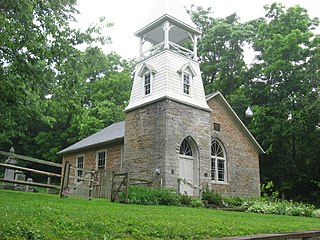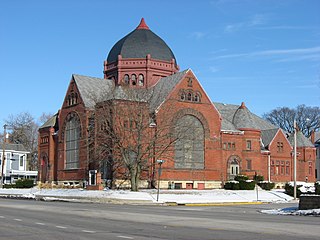
The former Nast Trinity United Methodist Church, now known as The Warehouse Church, is a historic congregation of the United Methodist Church in Cincinnati, Ohio, United States. Designed by leading Cincinnati architect Samuel Hannaford and completed in 1880, it was the home of the first German Methodist church to be established anywhere in the world, and it was declared a historic site in the late twentieth century.

The Cummins School is a historic former school building in Cincinnati, Ohio, United States. Built in 1871 in the neighborhood of Walnut Hills, it was later used as a model for the construction of other city school buildings.

St. Luke's Episcopal Church, formerly the Episcopal Church of the Resurrection, is a historic Episcopal church in the Sayler Park neighborhood of Cincinnati, Ohio, United States. Designed in the 1870s by master architect Samuel Hannaford, it has been named a historic site.

The Elmer Hess House is a historic residence in the city of Wyoming, Ohio, United States. Erected in the late nineteenth century, it was originally the home of a Cincinnati industrialist, and it has been designated a historic site because of its distinctive architecture.

The Hoodin Building was a historic apartment building in the Columbia-Tusculum neighborhood of Cincinnati, Ohio, United States. Built in 1881, it was once one of the neighborhood's most prestigious addresses. Despite its designation as a historic site, it is no longer standing.

The Charles H. Moore House is a historic residence in the city of Wyoming, Ohio, United States. Built in 1910 and home for a short time to a leading oilman, it has been designated a historic site.

The Northside United Methodist Church is a historic Methodist church in the Northside neighborhood of Cincinnati, Ohio, United States. Constructed in the 1890s for a congregation more than sixty years old, the building has been named a historic site.

The United Brethren in Christ Church, also known as "File Mile Chapel", is a historic church building located southeast of Cincinnati in Anderson Township, Hamilton County, Ohio, United States. Built in 1844, it is a stone building with a stone foundation and a slate roof. It was the house of worship for the oldest Church of the United Brethren in Christ congregation in southeastern Hamilton County, which became the mother of other congregations: some of its members later left to found other United Brethren in Christ churches elsewhere in Hamilton County and in the surrounding community.

Walnut Hills United Presbyterian Church is a historic church tower in the Walnut Hills neighborhood of Cincinnati, Ohio, United States. The last remnant of a landmark church building, it was designed by a leading Cincinnati architect and built in the 1880s. Although named a historic site a century after its construction, the building was mostly destroyed after extensive neglect caused restoration to become prohibitively expensive.

The Winton Place Methodist Episcopal Church is a historic church building in the Winton Place neighborhood of Cincinnati, Ohio, United States that was constructed as the home of a congregation of the Methodist Episcopal Church in the late nineteenth century. The congregation grew out of a group that was founded in 1856; although the members erected their first building in 1860, they were not officially organized until 1872. Among the leading members of the congregation was Samuel Hannaford, a prominent Cincinnati architect. When the congregation chose to build a new church building in 1884, Hannaford was chosen as the architect for the project. At this time, Hannaford was near to the peak of his prestige: he had ended a partnership with another architect seven years before, and his reputation was growing with his designs of significant Cincinnati-area buildings such as the Cincinnati Music Hall.

The Symmes Mission Chapel was a historic church building in the city of Fairfield, Ohio, United States. A simple structure constructed in the 1840s, it was named a historic site in the 1980s, but it is no longer standing.

St. Anthony's Catholic Church is a historic Roman Catholic church in Padua, an unincorporated community in Washington Township, Mercer County, Ohio, United States. Built in the late nineteenth century, it remains the home of a functioning congregation, and it has been recognized as a historically significant building because of its architecture.

First Presbyterian Church is a Presbyterian church in the city of Napoleon, Ohio, United States. Located at 303 W. Washington Street, it has been recognized as a historic site because of its unusual architecture.

Third Presbyterian Church is a historic former Presbyterian church building in Springfield, Ohio, United States. A Romanesque Revival building completed in 1894 along Limestone Street on the city's northern side, Third Presbyterian is one of the final buildings designed by prominent Springfield architect Charles A. Cregar.

North Presbyterian Church is a historic Presbyterian church on the east side of Cleveland, Ohio, United States. Constructed in the 1880s, the church building has been named a historic site.

Pilgrim Congregational Church is a historic congregation of the United Church of Christ in Cleveland, Ohio, United States. Constructed in the 1890s for a congregation founded in the 1850s, it was named a historic site in the 1970s.

Independence Presbyterian Church is a historic church in the city of Independence, Ohio, United States. Constructed in the 1850s, the stone church building was originally home to a congregation heavily dependent on the local mining economy, but since the 1920s it has again been associated with an active congregation. It was named a historic site in the 1970s.

The Auburn Free Will Baptist Church is a historic former Baptist church building in Auburn Township, Geauga County, Ohio, United States. Constructed in the second quarter of the nineteenth century, it is no longer home to the congregation that built it, but it remains a significant component of the area's built environment, and it has been named a historic site.

First Presbyterian Church is a historic Presbyterian church building in the city of Troy, Ohio, United States. Built in the 1860s, it was the third building used by a congregation formed nearly fifty years earlier. A high-quality example of period Romanesque Revival architecture, it has been named a historic site.

St. Mary's Catholic Church is a historic Catholic church building in an eastern neighborhood of Dayton, Ohio, United States. Constructed at the beginning of the twentieth century, it remains home to an active parish. Its grand architecture has made it an aviator's landmark, and it has been named a historic site by the federal government.






















